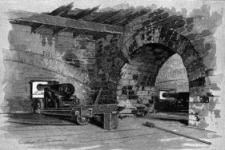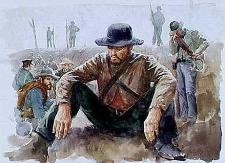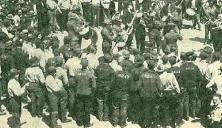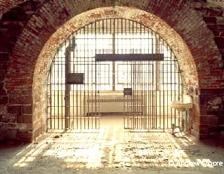
addition of the concrete-enclosed catwalks that currently dominate the Castle’s interior walls. 
Library of Congress Changing Times, Changing Needs Castle Williams, constructed in the early 19th century to protect New York Harbor, did its job without ever firing a shot during the War of 1812 - the British, detered by the show of force created by the network of fortifications, never entered the harbor during that conflict. Consequently, Castle Williams and the other harbor forts set a new standard for coastal defense structures. However, by the 1840s, changing technology, which allowed weapons to fire farther and more accurately, forever changed Governors Island's role in the defense of New York City and the nation. By the beginning of the American Civil War, Governors Island was no longer used primarily to physically defend New York Harbor, as it had been used for the decades since its construction, 
National Park Service A Question of Rank By the summer of 1861, the Civil War was in full swing, and both Union and Confederate governments had to deal with the inevitable collection of prisoners of war. Neither side was prepared to deal with so many captives, so, over the course of the war, each side respectively created 150 improvised prisons constructed out of everything from simple fences around swampland to abandoned warehouses. The US Army, scrambling to find lodgings for captured Southerners, turned to forts along the Atlantic coast, including old Fort Jay and Castle Williams. Captured officers were sent to the northern barracks of Fort Jay, while interred enlisted men were crammed into the old artillery casemates of Castle Officers kept in the barracks at Fort Jay were well treated. Their lodgings were snug but comfortable; they were allowed to stroll most of the island at their leisure; they were permitted to write home to their friends and families; and they occasionally played baseball in the fort's parade grounds. In general, officers on both sides respected each other and treated each other as gentlemen. Captured enlisted men, however, were kept in Castle Williams and experienced quite different circumstances: while the Castle was frequently kept well below capacity (at one point with as few as five prisoners), during at least two periods throughout the war it peaked at over 1,000 men. With many inmates per cell and no heating, running water, or beds - the structure had been built, after all, to house cannon, not people - conditions at the Castle were squalid. Disease was rampant: cholera, typhoid, and measles all were frequent killers, and the vomiting induced by these moisture-borne diseases made summertime inmates especially miserable. While those captured early in the war were occasionally given outdoor time, by the end of the war, all those interred within the walls of Castle Williams were confined to their cells twenty-four hours a day, seven days a week. These conditions mirrored those found in prisons throughout the South. 
Alex Leary Lieutenant Alonzo Etheridge Bell of the North Carolina Volunteers spent a few months in 1861 as a prisoner in the barracks at Fort Jay. He wrote at length about the prisoner's life on Governors Island, with passages describing the calm, comfortable climate in the officers' quarters, the pervasive boredom, and the constant funerals for the enlisted men dying in Castle Williams. Bell's spirits were clearly affected by the grim routine of a funeral every few days, though his status as an officer allowed him some separation from the worst conditions on the island. POW-related atrocities abounded elsewhere, too. Prisons both North and South at places like Elmira, NY, and, most famously, Andersonville, GA had death tolls in the thousands. Camp Sumter at Andersonville consisted of nothing more than fenced-off swamps into which hundreds of men were thrown and told to create shelter out of whatever materials they could find. The prisoners had to contend with pervasive disease and malnutrition along with greedy prison gangs, who would beat and even kill other prisoners for their food and shelter. Vigilante justice became common at these prisons - entire trials were held for captured gang members, ending frequently in punishments that included running the gauntlet and even execution by hanging. Compared to these prisons, Castle Williams was at least somewhat more habitable.
Collier’s Magazine A Different Kind of Prison Following the Civil War, the US Army vastly improved the facilities at Castle Williams, adding insulation, heating, running water, and, eventually, electricity. It was designated a US Army Prison in 1895 and was made a branch of the Fort Leavenworth Disciplinary Barracks in 1915, of which the prison facility at Alcatraz in San Francisco was also a branch. Castle Williams held mostly low-grade offenders, serving sentences of less than one year in a distinctly low-security environment. The Castle developed a reputation for being the most desirable location in the US Army prison system, and while the outstanding view from the fort and the friendly nature of the guards helped that reputation, the foremost cause was the shortage of hard labor to be performed on Governors Island—at Alcatraz, the prisoners had the backbreaking task of building their own cells out of heavy stones, while at Governors Island, there was little else to be done besides mowing the lawns or working as a courier. It was not an uncommon sight to see soldiers who had gone AWOL surrender themselves outside of the Battery Maritime Building, hoping to be imprisoned at Castle Williams. 
Andrew Moore Continued Service "Castle Bill", as it was endearingly called by its residents, remained a branch of the US Army Disciplinary Barracks until Governors Island's closure as an Army base in 1966. The Coast Guard did not maintain a prison in Castle Williams but readapted it for their own needs by using it as a community center featuring arts and crafts classrooms, a ballet studio, meeting rooms for the Boy Scouts and Girl Scouts, a daycare room, and a teen club. In 1970s, it was repurposed as a warehouse and landscaping shop, though, for every Halloween through 1996, a portion of the castle was used as a haunted house. Just as Castle Williams had originally been built for the purpose of protecting New York Harbor from foreign attack in the early 19th century and proceeded to spend over a century as a prison, the new Coast Guard base took the aging sentinel and continued to use it to fill their needs as a military installation and a burgeoning, small-town community. Today, the National Park Service has plans to continue this tradition by adapting the Castle for use as an interpretation center for New York Harbor, filling the casemates with exhibits relating to the historical, ecological, and cultural facets of the harbor and allowing visitors access to the roof to enjoy the tremendous view of New York Harbor. |
Last updated: February 26, 2015
